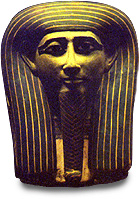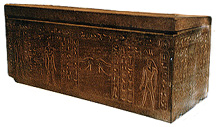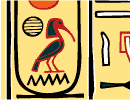|
Funeral masks
After about 1000 years of making mummies, the Egyptians came up with yet
another way to make sure the ba and ka could recognize their body. After the
mummy was wrapped, a mask was fitted over the head and shoulders. The faces on
these funeral masks resembled those of the dead, so the ba and ka could identify
the mummy as their own. Funeral masks were made out of solid gold (like King
Tut's), wood, or cartonnage (a material similar to paper-mâché). Wooden and
cartonnage masks were painted or gilded with gold.

cartonnage
mask
Coffins and sarcophagi
To further protect the mummy from possible damage, Egyptians often placed
them in one or more coffins. Like many other Egyptian burial customs, the styles
of the coffins changed over the thousands of years that mummification was
practiced.
  The earliest coffins of the Old Kingdom were boxy
and made of wood. Their decoration was usually very plain, with just some
hieroglyphics and a pair of wedjat eyes painted at the head end. The wedjat eyes
allowed the mummy to "see" into the world of the living. Painted below the
wedjat eyes was a false door to allow the spirit to come and go as it pleased.
As time passed, the decoration became more elaborate. Images of gods,
hieroglypics that spelled out protective prayers, and pictures of amulets
covered almost every square inch of these coffins. The earliest coffins of the Old Kingdom were boxy
and made of wood. Their decoration was usually very plain, with just some
hieroglyphics and a pair of wedjat eyes painted at the head end. The wedjat eyes
allowed the mummy to "see" into the world of the living. Painted below the
wedjat eyes was a false door to allow the spirit to come and go as it pleased.
As time passed, the decoration became more elaborate. Images of gods,
hieroglypics that spelled out protective prayers, and pictures of amulets
covered almost every square inch of these coffins.
During the Middle Kingdom, Egyptians began to make anthropoid (or mummiform)
coffins. Whether you call them anthropoid or mummiform, both words mean "human
shaped." Like the funeral masks, these coffins had faces that resembled the
person inside to help the ba and ka recognize it. Many of these were made of
cartonnage because it was cheap, light, and easy to shape and paint. Some of
these were gilded with gold as well.
These coffins were heavily decorated with hieroglyphics and pictures of gods
and magic symbols to protect the mummy on its way to the afterlife. Some of the
typical images to appear on coffins are pictured below.

And for even more protection, some mummies were placed into a sarcophagus. A
sarcophagus is a coffin made of stone. They are quite heavy (several tons) so
several men were required to position a sarcophagus into a tomb. Sarcophagi were
expensive, so only pharaohs and queens, priests and priestesses, viceroys,
nobles, and other important officials were buried in them. Like regular coffins,
sarcophagi were either rectangular or mummiform.
   
a pair of sarcophagi
|





